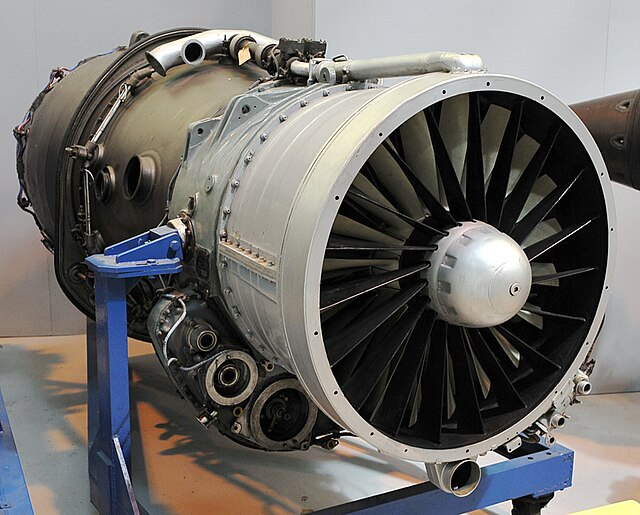Loading AI tools
British turbofan engine family From Wikipedia, the free encyclopedia
The Rolls-Royce Spey (company designations RB.163 and RB.168 and RB.183) is a low-bypass turbofan engine originally designed and manufactured by Rolls-Royce that has been in widespread service for over 40 years. A co-development version of the Spey between Rolls-Royce and Allison in the 1960s is the Allison TF41.
| Spey | |
|---|---|
 | |
| An RB.168 Mk 202 Spey as fitted to the F-4K Phantom | |
| Type | Turbofan |
| Manufacturer | Rolls-Royce Limited |
| First run | 1964 |
| Major applications | AMX International AMX BAC One-Eleven Fokker F28 Fellowship Blackburn Buccaneer McDonnell Douglas F-4K/M Phantom Xi'an JH-7 |
| Number built | 2,768 |
| Variants | Allison TF41 |
| Developed into | Rolls-Royce RB.183 Tay Rolls-Royce Marine Spey |
Intended for the smaller civilian jet airliner market when it was being designed in the late 1950s, the Spey concept was also used in various military engines, and later as a turboshaft engine for ships known as the Marine Spey, and even as the basis for a new civilian line, the Rolls-Royce RB.183 Tay.
Aviation versions of the base model Spey have accumulated over 50 million hours of flight time.[1] In keeping with Rolls-Royce naming practices, the engine is named after the River Spey.
In 1954 Rolls-Royce introduced the first commercial bypass engine, the Rolls-Royce Conway, with 17,500 lbf (78 kN) of thrust aimed at what was then the "large end" of the market. This was far too large for smaller aircraft such as the Sud Caravelle, BAC One-Eleven or Hawker Siddeley Trident which were then under design. Rolls-Royce then started work on a smaller engine otherwise identical in design derived from the larger RB.140/141 Medway - which itself had been cancelled after British European Airways (BEA) had demanded the downsizing of the Trident,[2] the RB.163, using the same two-spool compressor arrangement and a smaller fan delivering bypass ratios of about 0.64:1. Designed by a team under Frederick Morley,[2] the first versions of what had become the 'Spey' entered service in 1964, powering both the 1-11 and Trident. Several versions with higher power ratings were delivered through the 1960s, but development was ended nearing the 1970s due to the introduction of engines with much higher bypass ratios, and thus better fuel economy.
In 1980, Turbomecanica Bucharest acquired the license for the Spey 512-14 DW version, which propelled the Romanian built BAC One-Eleven aircraft (Rombac One-Eleven).[3]
Spey-powered airliners remained in widespread service until the 1980s, when noise limitations in European airports forced them out of service.
In the late 1950s the Soviet Union started the development of the Sverdlov-class cruisers that would put the Royal Navy at serious risk. The Naval Air Warfare Division[4] decided to counter this threat with a strike aircraft which would fly at very high speed at very low level. The winning design was the Blackburn Buccaneer.

The first version of the Buccaneer, the S.1 powered by the de Havilland Gyron Junior, was underpowered in certain scenarios, although not in maximum speed, and the engine was unreliable.[5] The Spey was chosen in 1960 as a re-engining option to give more thrust for a Buccaneer Mk.2. It was also predicted to increase range by 80%.[6] The engine was a militarized version of the BAC 1-11 Spey, and called the RB.168-1. The Buccaneer S.2 served into the 1990s.
A Spey derivative, designed and developed jointly by Rolls-Royce and Allison for the LTV A-7 Corsair II, was produced under licence in the United States as the TF41.
The British versions of the McDonnell Douglas F-4 Phantom II (designated Phantom FG.Mk.1 and FGR.Mk.2) replaced the 16,000 lb wet thrust J79 turbojets with a pair of 20,515 lb wet thrust Spey 201 turbofans. These provided extra thrust for operation from smaller British aircraft carriers, and provided additional bleed air for the boundary layer control system for slower landing speeds. The air intake area was increased by twenty per cent, while the aft fuselage under the engines had to be redesigned. Compared to the original turbojets, the afterburning turbofans produced a ten and fifteen per cent improvement in combat radius and ferry range, respectively, and improved take-off, initial climb, and acceleration, but at the cost of a reduction in top speed because compressor outlet temperatures would be exceeded in an essentially subsonic civil design.[7][8]
During its lifetime the Spey has achieved an impressive safety record. Its relatively low maintenance costs provide one of the major reasons it remained in service even when newer designs were available. With the need for a 10,000 to 15,000 lbf (44 to 67 kN) thrust class engine, with better specific fuel consumption and lower noise and emission levels, Rolls-Royce used Spey turbomachinery with a much larger fan to produce the Rolls-Royce Tay.
A fully updated version of the military RB.168 was also built to power the AMX International AMX attack aircraft.



Examples of the Rolls-Royce Spey are on public display at the:
Data from [citation needed]
Related development
Comparable engines
Related lists
Seamless Wikipedia browsing. On steroids.
Every time you click a link to Wikipedia, Wiktionary or Wikiquote in your browser's search results, it will show the modern Wikiwand interface.
Wikiwand extension is a five stars, simple, with minimum permission required to keep your browsing private, safe and transparent.